Coral scientists at NOAA’s Atlantic Oceanographic and Meteorological Laboratory (AOML) and University of Miami Cooperative Institute of Marine and Atmospheric Science (CIMAS) developed a new modeling approach, for evaluating coral reef persistence under climate change scenarios. Aiming to improve coral restoration efforts, this new user-friendly framework has been created as a helpful tool for coral reef scientists and managers to address the increasing vulnerability of these vital ecosystems.
A carbonate budget is a form of quantitative measure of the net carbonate production in a given reef environment. Carbonate production is a vital tool that corals possess as it essentially builds their internal skeleton, allowing corals to build entire reefs. Each coral polyp, which is an invertebrate organism, secretes this skeleton forming material, known as calcium carbonate. Calcium carbonate helps reefs survive and thrive, but it is also what is easily broken down by increasingly warm and acidic ocean conditions. Ocean acidification occurs primarily as a product of increased amounts of carbon dioxide being absorbed by our oceans. This increased absorption of carbon is due to the burning of fossil fuels and lowers the pH of ocean water, making it more acidic. This acidity makes it hard for corals to form their calcium carbonate skeletons, halting the formation of reef building corals. Warmer waters also cause the symbiotic algae organisms known as zooxanthellae to expel from the corals, causing them to bleach.

This new approach was recently published in Scientific Reports and has created the technique behind a user-friendly tool that is being built for managers to explore the persistence of their reefs of interest and to evaluate the potential impact of local initiatives to mitigate effects of ocean acidification and warming. According to lead author Dr. Alice Webb,
“We started this project because decision makers are limited by the lack of predictive tools used to assess regional responses under future climate change. To address these challenges, we’ve created a new user-friendly tool for the successful management of coral restoration initiatives.” – Dr. Alice Webb

This new framework will allow scientists and conservationists to evaluate reef persistence under scenarios of warming and ocean acidification, while exploring the outcomes of different restoration targets. It was first applied to Cheeca Rocks, an outlier reef in the Florida Keys in terms of high coral cover, carbonate production, and an abundance of the vulnerable mountainous star coral (Orbicella faveolata). This site was selected as a National Coral Reef Monitoring Program (NCRMP) sentinel site, as well as a reef targeted for the Mission: Iconic Reefs initiative.
The effects of coral thermal adaptation in the context of climate change was also examined by increasing the bleaching threshold of corals. Results from this study show that regardless of restoration or adaptation, net carbonate production at the Cheeca Rocks site declines once the threshold for annual severe bleaching is reached. Scientists believe that a combination of restoration efforts and coral thermal adaptation have the potential to delay the onset of mass bleaching mortalities at Cheeca Rocks and supply the time needed until a low-carbon economy is implemented.
– –
Webb, A.E., Enochs, I.C., van Hooidonk, R., van Westen, R., Besemer, N., Kolodziej, G., Viehman, S., Manzello, D. Restoration and coral adaptation delay, but do not prevent, climate-driven reef framework erosion of an inshore site in the Florida Keys. Sci Rep 13, 258 (2023). https://doi.org/10.1038/s41598-022-26930-4
